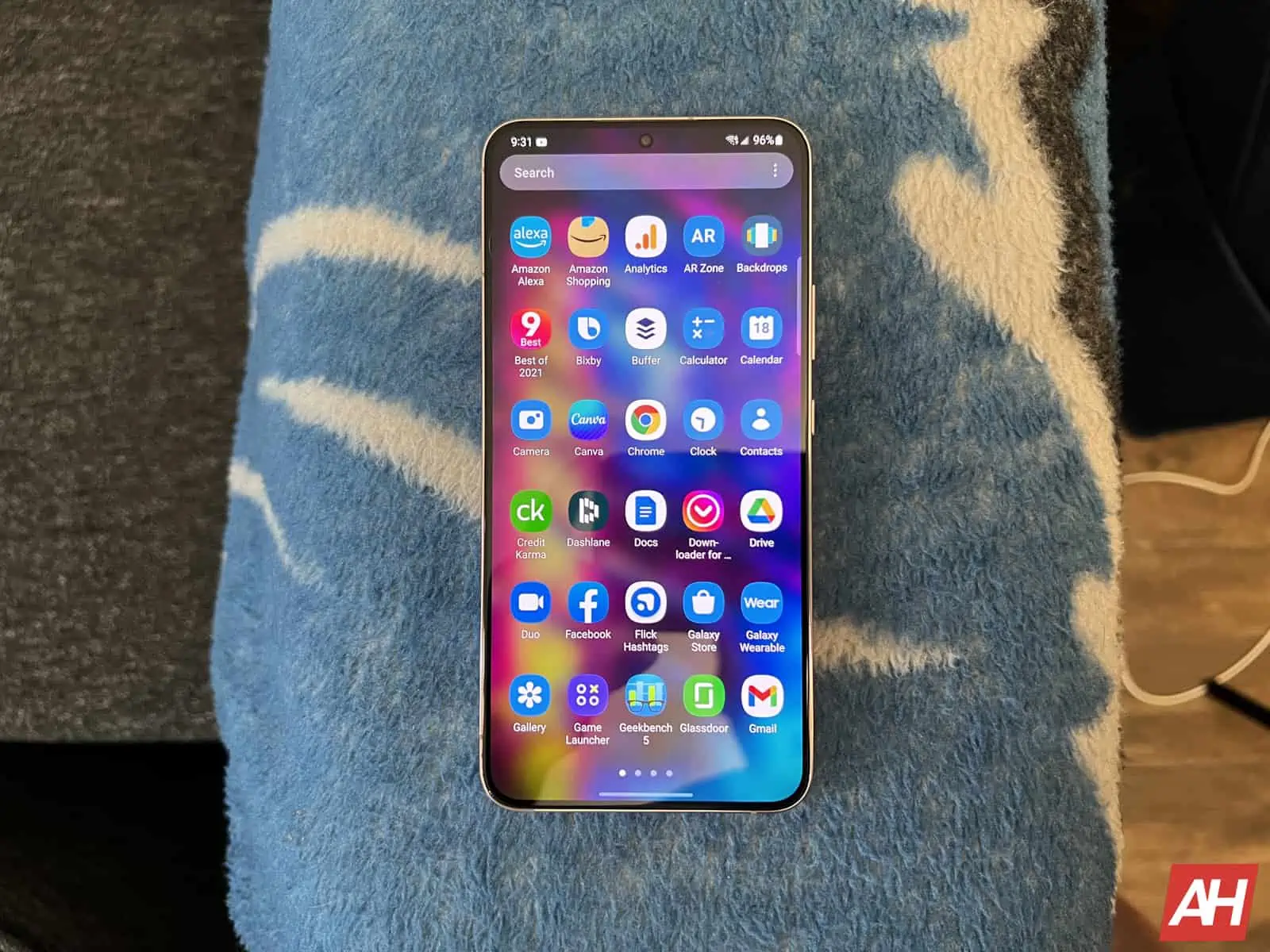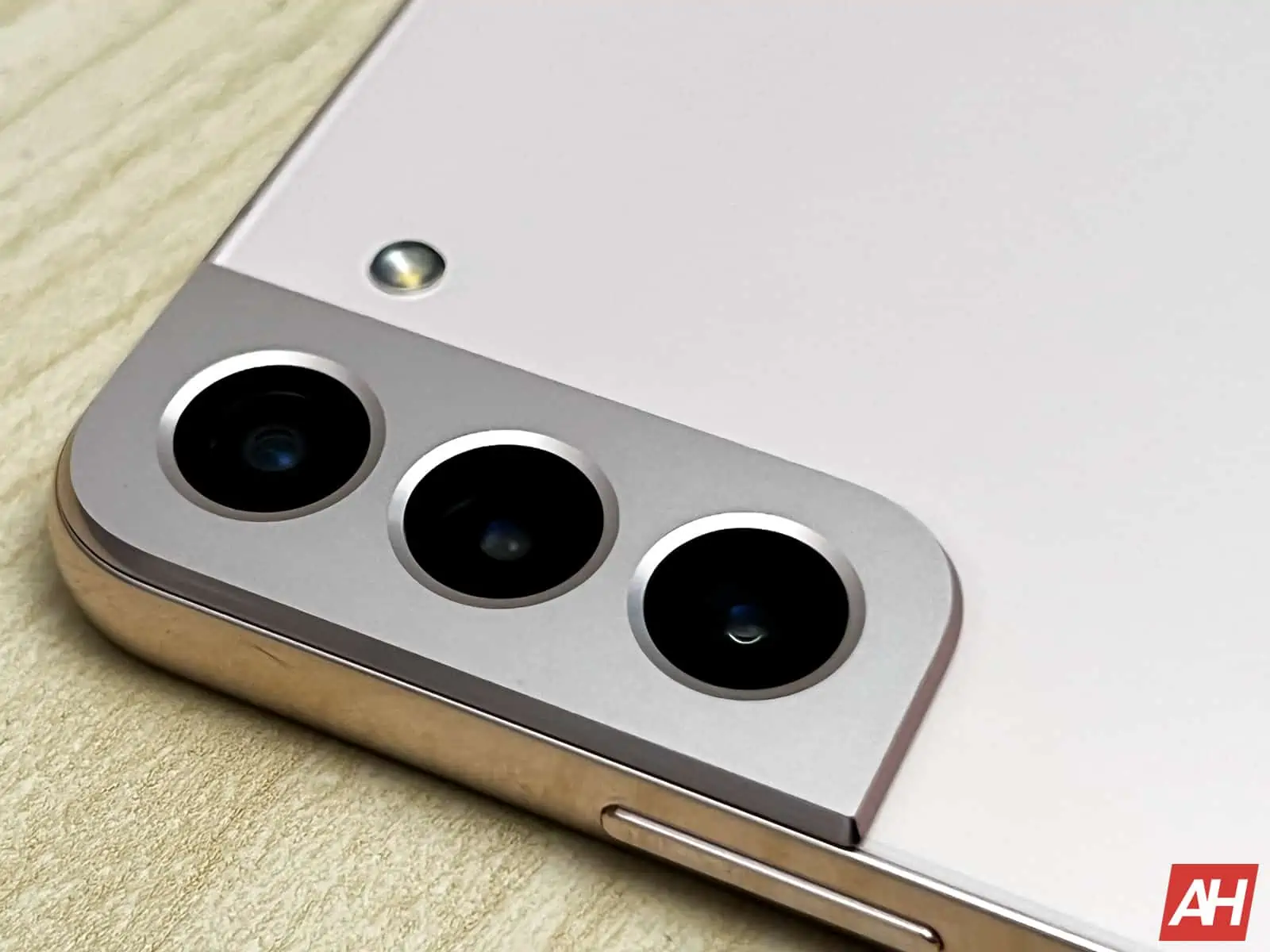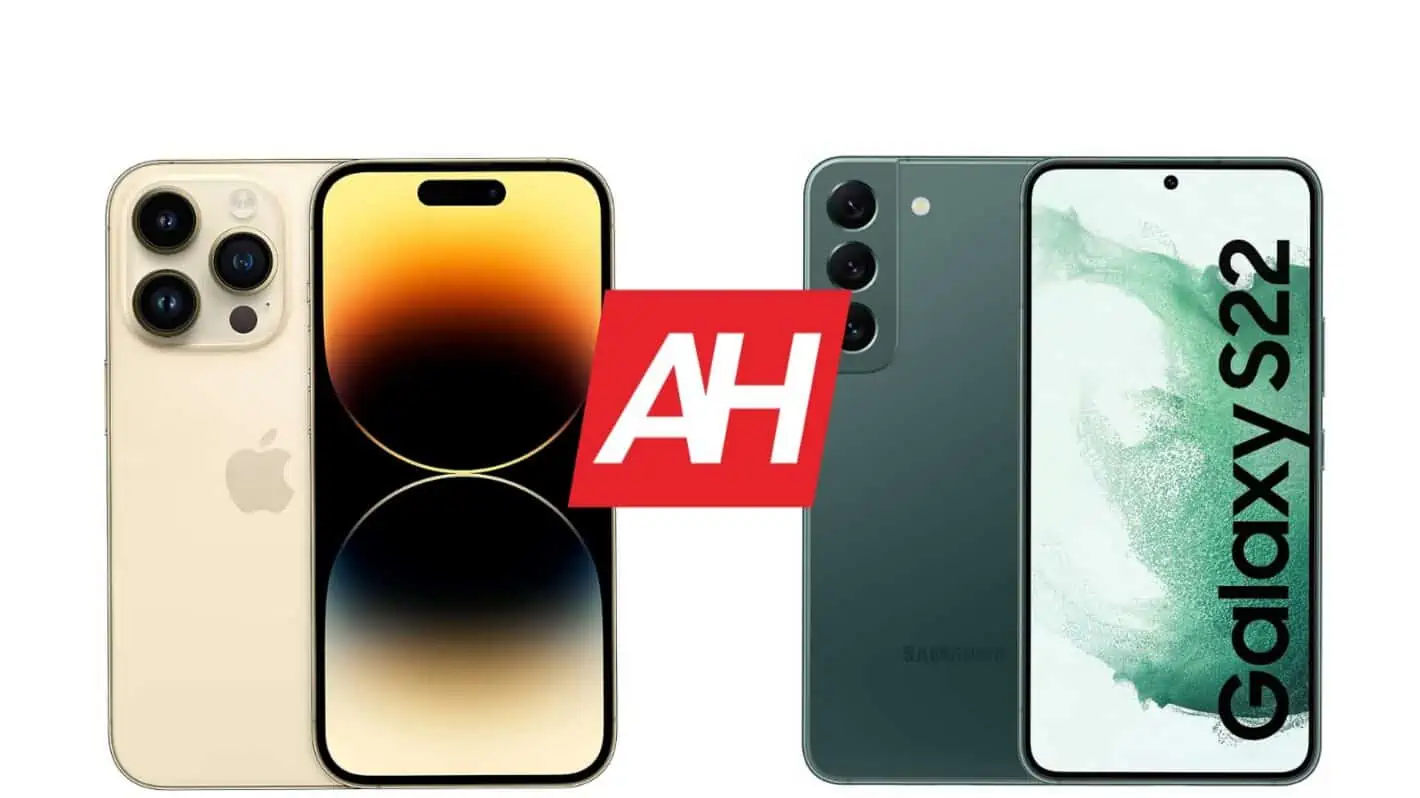Apple announced its new iPhone 14 and 14 Pro smartphones quite recently. One of the first phones that came to mind when we saw the iPhone 14 Pro was the Samsung Galaxy S22. Why? Well, mainly because they have the display of the same size, and they’re also quite similar in size in general. They’re also a part of the flagship smartphone line from both companies. So, it makes sense to compare them. We’ll compare the Apple iPhone 14 Pro vs Samsung Galaxy S22 in this article.
As per usual, we’ll first list the specs of both smartphones, and will then move on to compare them across a number of categories. We’ll go from design, display, and performance categories, to battery, cameras, and audio categories. These two phones not only look different, but have different internals, and completely different software. Still, comparing them will be quite interesting, as quite a few people will likely be deciding which one of these two phones to get.
Specs
| Apple iPhone 14 Pro | Samsung Galaxy S22 | |
| Screen size | 6.1-inch LTPO Super Retina XDR OLED display (120Hz refresh rate) | 6.1-inch FullHD+ Dynamic AMOLED 2X display (120Hz adaptive refresh rate) |
| Screen resolution | 2556 x 1179 | 2340 x 1080 |
| SoC | Apple A16 Bionic | Qualcomm Snapdragon 8 Gen 1 or Samsung Exynos 2200 |
| RAM | 6GB | 8GB (LPDDR5) |
| Storage | 128GB, 256GB, 512GB, 1TB, non-expandable | 128GB/256GB, non-expandable |
| Rear cameras | 48MP (f/1.8 aperture, wide-angle, 1.22um pixel size, sensor-shift OIS, dual pixel PDAF) 12MP (ultrawide, f/2.2 aperture, 13mm, 120-degree FoV, 1.4um pixel size, dual pixel PDAF) 12MP (telephoto, f/2.8 aperture, 77mm lens, PDAF, OIS, 3x optical zoom) |
50MP (f/1.8 aperture, 24mm lens, OIS, Dual Pixel PDAF, 1.0um pixel size) 10MP (f/2.4 aperture, 70mm lens, telephoto, 1.0um pixel size, OIS, PDAF, 3x optical zoom) 12MP (ultrawide, f/2.2 aperture, 13mm lens, 120-degree FoV, 1.4um pixel size) |
| Front cameras | 12MP (wide-angle, f/1.9 aperture, 23mm lens, PDAF) SL 3D (depth/biometrics sensor) |
10MP (f/2.2 aperture, 1.22um pixel size, 26mm lens, Dual Pixel PDAF) |
| Battery | 3,200mAh, non-removable, 23W wired charging, 15W MagSafe wireless charging, 7.5W Qi wireless charging, 5W reverse wireless charging | 3,700mAh, non-removable, 45W wired charging, 15W Qi wireless charging, 5W Wireless PowerShare |
| Dimensions | 147.5 x 71.5 x 7.9mm | 146 x 70.6 x 7.6mm |
| Weight | 206 grams | 167 grams |
| Connectivity | 5G, LTE, NFC, Bluetooth 5.3, Wi-Fi, Lightning port | 5G, LTE, NFC, Bluetooth 5.2, Wi-Fi, USB Type-C |
| Security | Advanced facial scanning | In-display fingerprint scanner (ultrasonic) |
| OS | iOS 16 | Android 12 One UI 4.1 |
| Price | $999 | $799 |
| Buy | Apple | Samsung |
Apple iPhone 14 Pro vs Samsung Galaxy S22: Design
As you can see in the provided image above, the two phones look completely different. Their overall shape is somewhat similar, but that’s it. The iPhone 14 Pro has uniform bezels, and a pill-shaped cutout at the top of the display. The Galaxy S22 includes a much smaller cutout, that is also centered, and immensely thin bezels too. Both phones have flat displays, and both have glass on the front and back. The iPhone 14 Pro includes a stainless steel frame, while the Galaxy S22 has an aluminum frame.
If we flip them over, we’ll see two considerably different camera setups. The iPhone 14 Pro’s camera setup is a part of the camera island that is placed in the top-left corner. It has that well-known setup that iPhones have been rocking for a while now. There are three cameras back there plus a ToF 3D LiDAR sensor. The Galaxy S22’s camera setup is protected by metal, which protrudes from the phone’s frame. The phone includes three cameras on the back.
These two devices are almost identical in terms of size. The iPhone 14 Pro is slightly taller, wider, and thicker. It is considerably heavier, though. It weighs 206 grams, compared to only 167 grams of the Galaxy S22. The main reason for that is the stainless steel frame, but not the only reason, of course. Both phones are considerably slippery, though the Galaxy S22 is easier to use with one hand due to its weight. It’s also more pleasant to use because of it, the iPhone 14 Pro’s design and weight can cause hand fatigue during one-hand use. That won’t be the case for everyone, though, of course. Both devices feel immensely premium in the hand.
Apple iPhone 14 Pro vs Samsung Galaxy S22: Display
Both phones include 6.1-inch displays, but they’re different panels. The Apple iPhone 14 Pro features a 6.1-inch 2556 x 1179 LTPO Super Retina XDR OLED display. That is a 120Hz display, which is flat, and it supports HDR10 content. It also supports Dolby Vision, and gets extremely bright at 2,000 nits of peak brightness. This display is protected by scratch-resistant ceramic glass, and has a 460 ppi.

The Samsung Galaxy S22, on the other hand, features a 6.1-inch fullHD+ (2340 x 1080) Dynamic AMOLED 2X display. That panel is also flat, and it supports a 120Hz refresh rate. It also supports HDR10+ content, and gets up to 1,300 nits of brightness at its peak. The panel is protected by the Gorilla Glass Victus+, and we’re looking at a ppi of 425 here.
Now, both of these panels are truly excellent. They both offer great viewing angles, vivid colors, and they’re quite responsive. They’re also more than sharp enough, and feel extremely smooth thanks to their refresh rates, which are well-optimized. That being said, if I had to nitpick, I’d go for the iPhone’s panel. Why? Well, that brightness is really hard to beat, and it’s also a bit sharper overall. Almost everyone will be more than happy with either of these, though.
Apple iPhone 14 Pro vs Samsung Galaxy S22: Performance
First and foremost, let’s just say that the Galaxy S22 comes in two different SoC variants. In Europe, the Exynos 2200 fuels the phone. Everywhere else, you’ll find the Snapdragon 8 Gen 1 on the inside. The Snapdragon variant offers notably better performance, and also better camera performance and power efficiency. That’s the variant we used, so that’s the one we’ll compare here. The phone also includes 8GB of LPDDR5 RAM. The iPhone 14 Pro, on the flip side, is fueled by the Apple A16 Bionic SoC, and includes 6GB of RAM.
Is the performance any good on these two phones? Well, yes, it’s excellent, actually. The Galaxy S22 technically has an inferior SoC, but it holds its own, even in gaming. We did notice a bit more stuttering on the Galaxy S22, but nothing that should be specifically noted. There was no lag to speak of, per se, and the phone performed really well. When it comes to regular, everyday tasks, you have nothing to worry about, while they both can also handle pretty much any game you can find in their respective app stores.
Apple iPhone 14 Pro vs Samsung Galaxy S22: Battery
The iPhone 14 Pro comes with a 3,200mAh battery pack. The Galaxy S22 includes a 3,700mAh battery. That being said, iPhones do handle battery consumption differently, and that 3,200mAh is actually a good size for this phone. The same cannot be said for the Galaxy S22, though, unfortunately. That 3,700mAh battery pack is kind of small for that SoC, display size, resolution, and refresh rate.
The iPhone 14 Pro, based on the initial numbers, actually offers a really good battery life. It all depends on your usage and some other factors, though, of course, but without gaming as part of the equation, and regular usage, you can get over 7 hours of screen-on-time, if not more. The Galaxy S22 cannot really come to such numbers. We’ve been able to pull out less than 6 hours of screen-on-time most of the time, it was closer to 5 hours. If you do put gaming into the picture, or you end up taking a lot of pictures and recording plenty of video clips, those numbers will go down fast, on both phones. Your mileage may vary, of course, you may get completely different results.
Both phones do support wired and wireless charging. The iPhone 14 Pro has support for 23W wired, 15W MagSafe wireless, and 7.5W Qi wireless charging. The Galaxy S22 supports 25W wired, 15W wireless, and 4.5W reverse wireless charging. Do note that neither phone includes a charger in the box, though, that’s something you’ll have to buy separately.
Apple iPhone 14 Pro vs Samsung Galaxy S22: Cameras
With the iPhone 14 Pro series, Apple finally bumped up the main camera hardware. The device comes with a 48-megapixel main camera, and it’s actually quite good. The Galaxy S22 has a 50-megapixel main camera, in addition to 12 and 10-megapixel ultrawide and telephoto cameras, respectively. The iPhone 14 pro includes 12-megapixel ultrawide and telephoto cameras on the back.

The main difference you’ll note when comparing pictures from the two cameras is in the colors and saturation. The Galaxy S22 provides more saturated images, which also look more vivid as a result. The iPhone 14 Pro is closer to real–life images, though you have shooting styles to scroll through. Images provided by the iPhone 14 Pro are usually a bit sharper, though you won’t notice that until you zoom in quite a bit.
The iPhone 14 Pro does currently have a problem with highlights at times, but the color consistency between its cameras is better than on the Galaxy S22. Its ultrawide camera also does a better job overall, and the slow-motion video is better as well. The Telephoto cameras are great on both phones. The two devices also do a good job in low light, across the board.
Audio
First and foremost, there is no audio jack on either one of these two phones. There is a lightning port on the iPhone 14 Pro, and a Type-C USB port on the Galaxy S22. So, you’ll either have to use a dongle, earphones with the proper adapter, or Bluetooth. The two phones support Bluetooth 5.3 and 5.2, respectively.
You will find stereo speakers on both devices. The ones on the Galaxy S22 are tuned by AKG. Both sets of speakers are really good. They’re punchy, loud, and well-balanced. You won’t notice any distortion, unless you really crank them up all the way up, in which case you may notice slight distortion, but it’s almost not noticeable. Both sets of speakers do offer some bass, and are overall really, really good.

